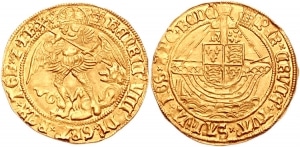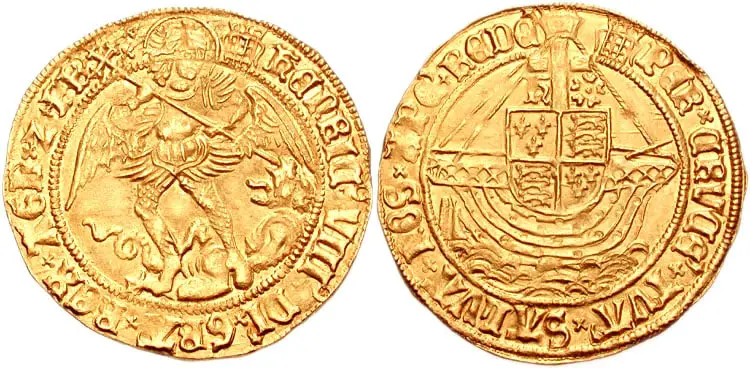Historic Value of the Angel Coins
When the angel coin was first issued under King Edward the Eight’s reign, it was worth 6 shillings and 8 pence. Then, when Henry the Eighth came to power in 1509, the coin increased in value and was worth seven shillings and sixpence or 90 pence, and it continued to increase in 1544 what it was valued at 8 shillings or 96 pence.
Six years later, under the reign of Edward the sixth, it increased again and was worth 10 shillings. Finally, under the rule of James the first in 1612, it rose all the way up to eleven shillings or 132 pence. However, from that point on, it began to decrease in value and by 1619 was back down to being worth only ten shillings.
So, as you can see, the value of the Angel coin varied greatly under the different reigns of various Monarchs.
How much is an Angel coin worth today?
But, what is the angel coin worth today? Well, for an angel coin in almost any condition, you are looking in the region of around £1000 or likely over. If you are wanting an angel coin in prime condition, you will need to have quite a bit saved before you can consider buying one.
In 2017 there was a half-angel that was found in a field by someone with a metal detector. This version of the coin is one of the few that were minted during the reign of Richard the third and went for £34,000 at auction.
If that price range is a bit too steep for you, there is another option. Every year at Christmas, the Isle of Man produces an angel coin. The coin comes in several different sizes and can be made from a variety of different metals. This modern version of the traditional angel coin is often much closer to people’s budgets. The smallest version of the coin typically starts at around £75 and makes a great present or collectable.
The History of Angel Coins
The angel is a gold coin that was first introduced in England by King Edward the Fourth in 1465; however, it was modelled after a coin more than a hundred years older.
In the 1340s, there was a coin introduced in France that was referred to as the angelot or ange. The French version of the coin was most popular under King Phillip the Sixth and then later King Louis the Eleventh. However, the French version of the coin did have slightly different depictions and slightly different evaluations.
It is also important to note that even nearer to the time when King Edward the Fourth introduced the angel, there was a version issued by Henry the Sixth who ruled England and parts of France, though that fact is disputed.
When the angel coin was crafted, it was designed with two intricate images. On the obverse or the front side of the coin, there was a picture of the Archangel Michael, hence the name of the coin, slaying a dragon. The scene is supposed to depict a part of the biblical book of Revelations where Michael is described as leading God’s army to fight Satan, who, in the coin, is represented by the dragon.
Around the depiction is the inscription “HENRIC VIII DI GRA REX AGL & FR.” The inscription translates to, “Henry the Eighth, by the Grace of God King of England and France.” The name of the Monarch here changed depending on who was on the Throne at the time of minting.
On the back or the reverse side of the coin, you would find another intricate picture. This one is the depiction of a ship or, more specifically, an English galley out at sea. Below the topmast of the ship, it is monogrammed with an H and a rose, and there is a shield bearing the King’s arms surmounted onto the ship. This side of the coin was also inscribed and read “PER CRVCE TVA SALVA NOS XPC REDE,” which is a saying that translates to “Through Thy cross save us, Christ Redeemer.”

The original version of the coin issued by King Edward the Fourth was the coin that replaced the gold noble coin. The Noble was a very popular coin that circulated through much of the country along with the smaller versions of the Noble referred to as the half Noble and the quarter Noble. Because the angel replaced the Noble, some people referred to it as the angel-noble rather than just the angel.
Magical power of the Angel Coin
In the middle ages, many people believed that the angel coin had some sort of magical property that could help cure people of scrofula, which was referred to, at the time, more commonly as the king’s evil. Because people believed that the simple touch of the angel coin could cure the ill, it was often presented to the sick during a ceremony. Even after the coin was no longer minted, people would use similar medals called touch pieces to help the sick.
The end of the Angel Coin Era
The coin remained a popular English coin until the seventeenth century, though it did change values at several different points in time and under several different reigns. There was even a similar coin, known as the half-angel, that had a very similar design.
However, as mentioned previously, the coin was no longer produced starting in the seventeenth century – or 1633 – to be exact. At that point in time, King Charles the Second replaced all pre-existing coins with new coins with all new designs called milled coins, which meant that the images on the coins were struck by a machine rather than struck by hand, which in turn sped up production significantly. Charles the Second established Guinea as the gold standard.
Nevertheless, the angel, and in turn the half-angel, was certainly one of the most iconic coins in English history. In fact, it was such an iconic coin that there have been a number of English pubs named after it. One of these pubs was the Angel Inn, which is in Islington, and it is where the Angel tube station got its name.
Final Thoughts
Thank you for taking the time to read this article. If you’re interested in learning more about historical coins check out some of our other blog posts!
